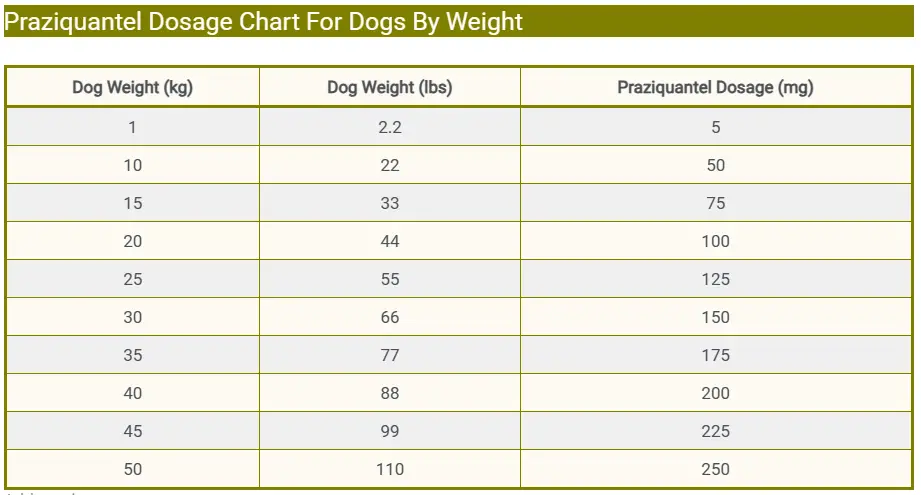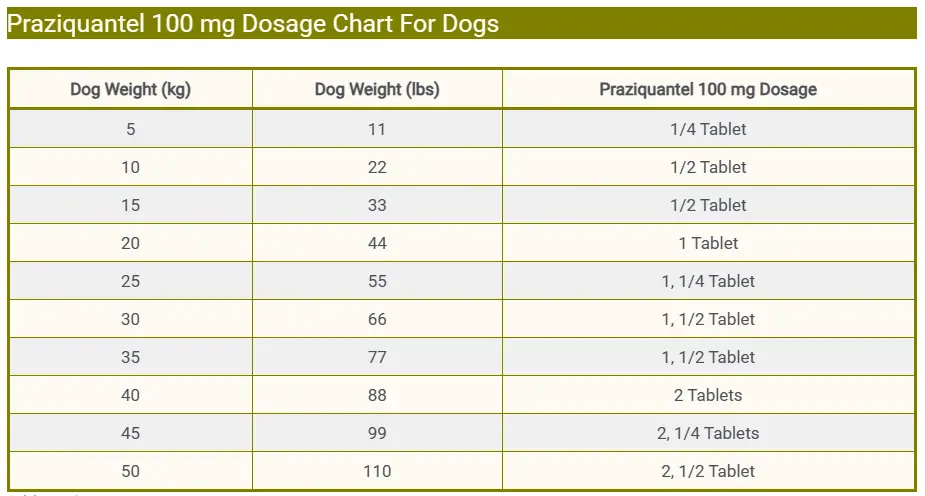The ideal dosage of Praziquantel for dogs to treat gastrointestinal parasitosis is 5 mg/kg. This means that a 20 kg dog can be given one 100mg Praziquantel tablet once daily for 15 days. Additionally, a systematic or preventive deworming plan can be implemented every 60-90 days to maintain the health of the dog and prevent parasitic infestations.
Praziquantel Dosage For Dogs

-
Ideal Dose: 5.5 mg/kg (2.5 mg/lb).
-
Uses: For the control of gastrointestinal parasitosis.
-
FDA Approved: Yes
-
Brand Names: Droncit®, Drontal®, Biltricide®, Bio-Cest®, Cercon®, Cesol®, Cestox®, Cisticid®, ComboCare®, Cysticide®, Ehliten®, Equimax®, Extiser Q®, Mycotricide®, Opticide®, Quest Plus®, Praquantel®, Prasikon®, Prazite®, Prozitel®, Sincerck®, Teniken®, Virbantel®, Waycital®, or Zifartel®, and Zimecterin
-
Variants: Tablets.
-
Storage & Handling: Store below 25 degrees Celsius, protected from light, in a hygienic place.
-
Administration: Once Daily.
Disclaimer: Self-medication can be hazardous. Please consult your veterinarian for personalized guidance on the appropriate dosage for your furry friend’s specific condition.
As pet owners, ensuring the health and well-being of our furry companions is a top priority. One aspect of responsible pet care involves protecting them from internal parasites such as tapeworms. Praziquantel, a medication commonly used to treat tapeworm infections in dogs, is crucial in this endeavor.
However, understanding the appropriate dosage and administration of praziquantel is essential to safeguard our canine friends against these pesky parasites effectively.
In this blog post, we’ll delve into the specifics of praziquantel dosage for dogs, providing insight into how to administer this medication safely and effectively.
Praziquantel Dosage For Dogs
The dosage of praziquantel for dogs typically depends on their weight and the specific formulation of the medication being used. However, a common dosage range is 5 mg/kg (02.27 mg/lb) of body weight. However, a systematic or preventive deworming plan can be implemented every 60-90 days to maintain the health of the dog and prevent parasitic infestations.
This dosage is typically administered orally as a single dose, although your veterinarian may recommend a different dosing schedule based on your pup’s individual needs and the type of parasite being treated.
Always consult with your veterinarian before administering any medication to your canines to ensure proper dosage and administration.
Praziquantel Dosage Chart For Dogs By Weight
| Dog Weight (kg) | Dog Weight (lbs) | Praziquantel Dosage (mg) |
|---|---|---|
| 1 | 2.2 | 5 mg |
| 5 | 11 | 25 mg |
| 10 | 22 | 50 mg |
| 15 | 33 | 75 mg |
| 20 | 44 | 100 mg |
| 25 | 55 | 125 mg |
| 30 | 66 | 150 mg |
| 35 | 77 | 175 mg |
| 40 | 88 | 200 mg |
| 45 | 99 | 225 mg |
| 50 | 110 | 250 mg |
The above Praziquantel dosage chart for dogs by weight is provided for educational purposes only and should not substitute for veterinary advice. Always start with the minimum dose until your veterinarian prescribes an increase in dosage.
Praziquantel 100 mg Dosage Chart For Dogs
| Dog Weight (kg) | Dog Weight (lbs) | Praziquantel 100 mg Dosage |
|---|---|---|
| 5 | 11 | 1/4 Tablet |
| 10 | 22 | 1/2 Tablet |
| 15 | 33 | 1/2 Tablet |
| 20 | 44 | 1 Tablet |
| 25 | 55 | 1, 1/4 Tablet |
| 30 | 66 | 1, 1/2 Tablet |
| 35 | 77 | 1, 1/2 Tablet |
| 40 | 88 | 2 Tablets |
| 45 | 99 | 2, 1/4 Tablets |
| 50 | 110 | 2, 1/2 Tablet |
Related Post: Apoquel Dosage For Dogs
Praziquantel Uses in Dogs
Praziquantel is commonly used in dogs to treat various parasitic infections, particularly those caused by tapeworms. These parasites can infect dogs through ingestion of contaminated food, water, or intermediate hosts like fleas and rodents.
Here are some key uses of praziquantel in dogs:
-
Treats tapeworm infections caused by Dipylidium caninum, Taenia spp., and Echinococcus multilocularis
-
Effective against schistosomiasis (schistosome infections) in dogs
-
Occasionally used off-label for liver fluke infections (Fasciola hepatica)
-
Included in some heartworm prevention products for additional parasite control
-
Can treat bilharzia (schistosomiasis) in dogs caused by certain blood fluke species (Schistosoma)
Related Post: Clindamycin Dosage For Dogs
Praziquante Side Effects in Dogs
-
Vomiting
-
Diarrhea
-
Loss of appetite
-
Lethargy
-
Excessive drooling
-
Itching or scratching
-
Allergic reactions (rare)
-
Behavioral changes
-
Incoordination or unsteadiness
Which Dogs Should Not Take Praziquante.
Canines with the following health issues should not take Praziquante without veterinary recommendations.
-
Dogs with a known hypersensitivity or allergy to Praziquantel or its ingredients.
-
Dogs with severe liver or kidney disease, unless under close veterinary supervision.
-
Pregnant or nursing dogs, unless prescribed and deemed necessary by a veterinarian.
-
Do not administer in weakened canines, or in situations of intense stress.
FAQs
How often should I deworm my dog with praziquantel?
Dogs should be dewormed with praziquantel at least once every three to six months, although more frequent deworming with vet advice may be necessary depending on the dog’s risk of exposure to tapeworms.
Can praziquantel be used to treat other types of parasites?
Praziquantel is specifically designed to treat tapeworm infections in dogs and may not be effective against other types of parasites. Your veterinarian can recommend alternative medications for treating other parasitic diseases.
Are there any natural alternatives to praziquantel for deworming dogs?
While some natural remedies are believed to have deworming properties, their effectiveness may vary, and they may not be as reliable as pharmaceutical medications such as praziquantel. It is essential to discuss any alternative treatments with your veterinarian before administering them to your dog.
What should I do if my dog experiences side effects from praziquantel?
If your dog experiences any adverse reactions to praziquantel, such as vomiting, diarrhea, or lethargy, it is essential to contact a veterinarian immediately. They can guide managing the side effects and whether further treatment is necessary.
Can praziquantel be given to puppies?
Praziquantel is generally safe for puppies, although the dosage may need to be adjusted based on age and weight. It is essential to consult a veterinarian for appropriate dosing recommendations for puppies.





![Can Dogs Eat Blood? 7 Side Effects [Expert Opinion]](https://petskor.com/wp-content/uploads/2022/04/Webp.net-resizeimage-12.jpg)
